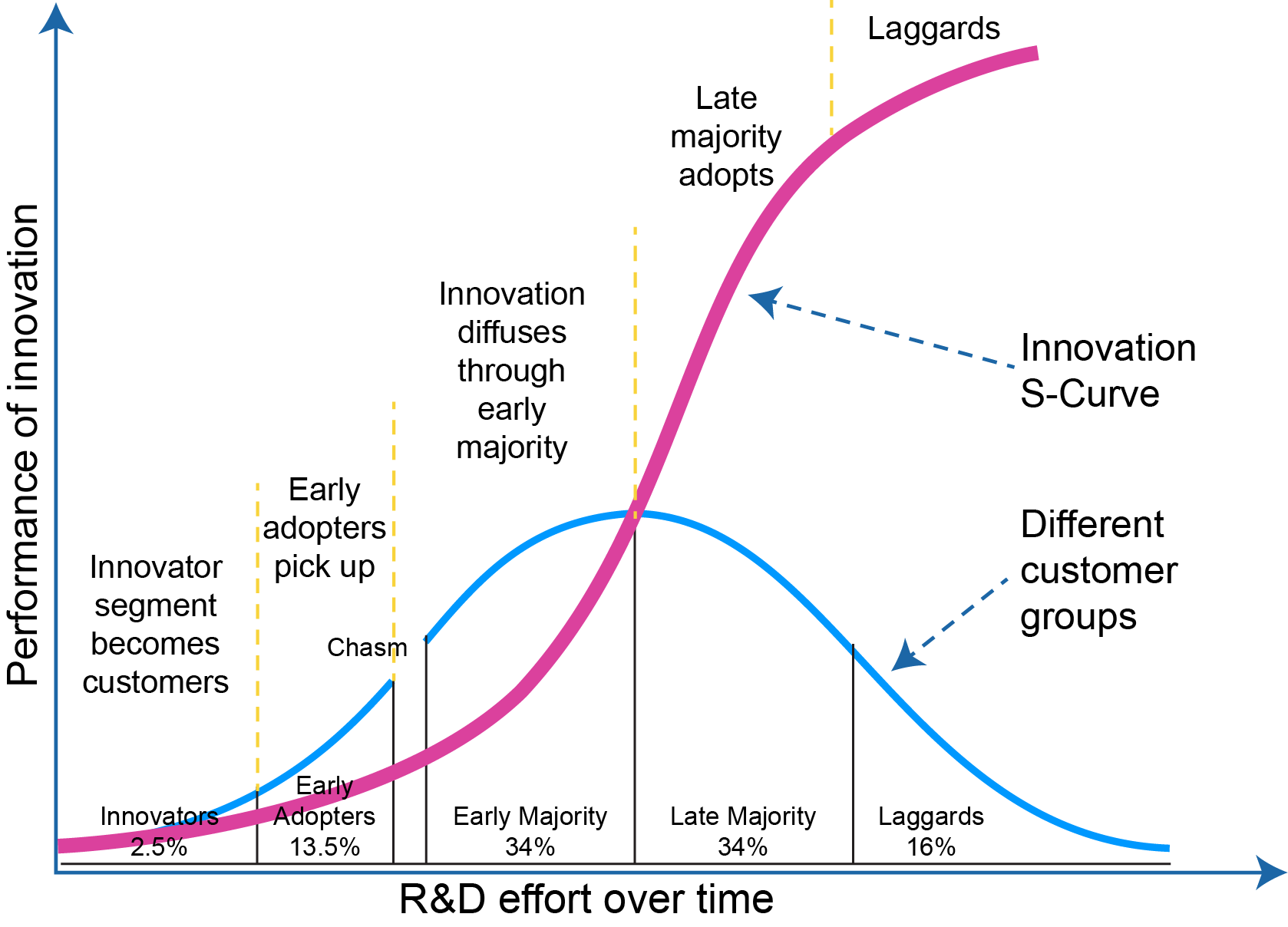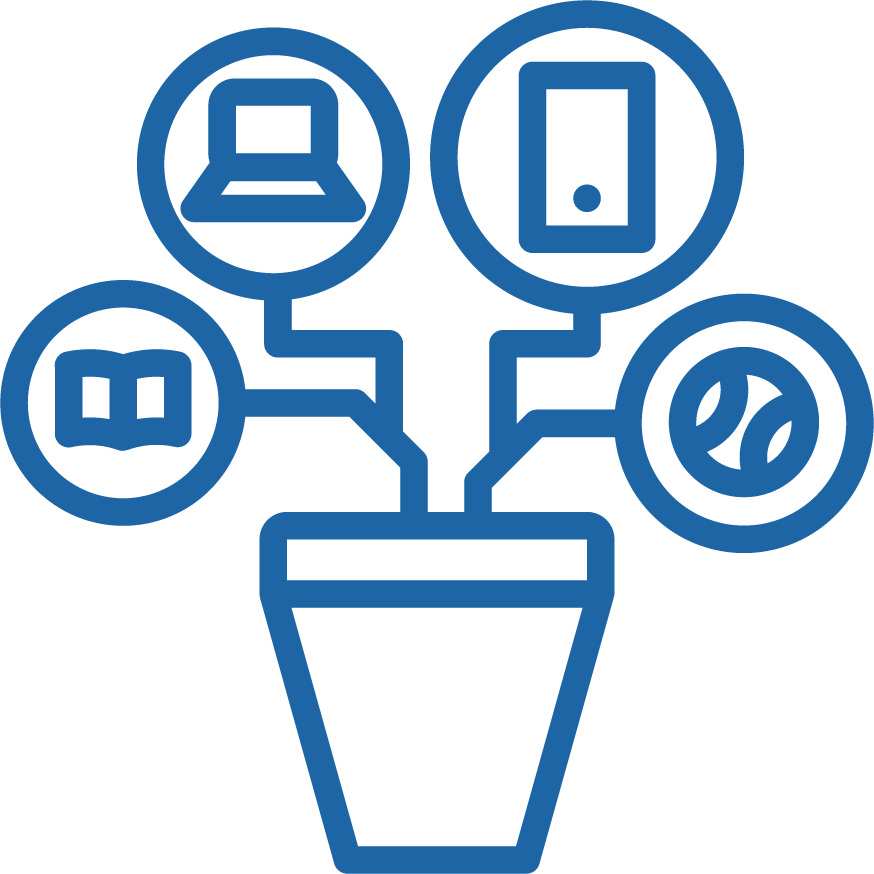| Overview | Prepare to Scale | Envision Scaled Implementation | Set Scaling Goals | Identify a Pathway | Build Your Team | Go to Market |
|---|
Set Scaling Goals
Scaling goals are clear objectives that provide direction and motivation to your endeavor and ensure your transition strategies align with your vision and purpose for scaling. Your goals for scaling can help you identify a suitable pathway and sustainable model for generating revenue. As you further develop your scaling plan, you will likely refine your goals to make them more specific, measurable, and time-bound. But to start, sketch out what you think success will look like in 3–5 years. For reference, the table below provides sample high-level scaling goals.
| Scaling Goal | Example Targets | Story of Scaling |
|---|---|---|
| Make your product publicly available for free or at a very low cost, and charge only for select services, such as training or upgrades, to cover maintenance. | Generate revenue from services in a certain quantifiable user or unit count (e.g., 1,000 users or 5 to 10 districts). | Field Day Story of Scaling |
| Support continued operations, improvement, and growth by generating recurring revenue from product sales. | Generate sales revenue by a certain percentage or certain quantifiable user or unit count (e.g., 10,000–20,000 users or 200 to 400 districts/units). | Inq-ITS Story of Scaling |
| Ensure your innovation reaches certain populations (e.g., rural classrooms, under-resourced schools, or dual-language immersion schools). | Serve a certain percentage of users across a specific market segment. | Pictoword School Story of Scaling |
To set more specific goals around adoption, revenue, and awareness, start by defining your ideal customer. This will help you develop early parameters for the market share you can realistically reach, determine the associated revenue you can generate, and focus your brand awareness and marketing goals.
Identifying Your Ideal Customer
A customer often refers to anyone who engages with a product, whether or not they pay for it. A market can be thought of as a giant pool of potential customers that share something in common, such as a need, a problem, or an interest in a specific product or service. Markets can be defined by various factors such as location, product type, or customer demographics. Knowing your target market and ideal customer will help you set realistic goals for scaling.
In the Apply section of this toolkit, you analyzed and segmented your market. To build on this, define the attributes of an organization (an Ideal Customer Profile) and the attributes of the individuals or target audiences within that organization (an Ideal Customer Avatar) who will benefit the most from your product and are most likely to buy or implement it. In other words, identify the “best match” for what you are offering.
An Ideal Customer Profile (ICP) is a clear description of the type of organization you want to target with your product. An ICP does not refer to any organization that might like your product—it refers to the organization that is most likely to need it, use it, and pay for it. This customer is also more likely to stay loyal to your brand and refer you to others. In scaling, it is best to focus on a specific customer that is most likely to benefit from your product.
Identifying your ICP helps you:
- Focus your efforts on the right tactics to reach the best-fit audience, instead of wasting resources on those who are not a good fit.
- Design a better product that solves a specific problem for this customer.
- Create targeted marketing messages that speak directly to the customer’s needs.
- Improve sales and business development efficiency because you are reaching out to those who are more likely to be interested in what you offer.
By narrowing down to the ideal customer, you make it easier to succeed and grow. The table below provides an example ICP for an elementary literacy intervention.
| What industry is your ICP in? | K–12 Education |
| What organizations represent your ICP? | Public and private elementary schools |
| Are there geographic attributes for your ICP? | U.S. mostly English-speaking countries as well |
| Are there any other school/district characteristics to inform your ICP? | Schools with more than 50% of grade 3 students reading below grade level. Schools with high multilingual learner populations |
| Are there ideal size parameters for your ICP? | No |
| Does your product serve a subset of your ICP? For example, is it grade level-specific? | Yes, K–3 |
| Are there any preexisting needs to inform your ICP? | Students reading below grade level. Need for Tier 2 and 3 intervention. |
| Are there any technology prerequisites that your ICP needs to use or have to successfully implement your product? | No |
| What funding would your ICP use to purchase or implement your product? | State grant funding for tutoring or reading intervention. |
Access the LEARN Go-to-Market Playbook to walk through process of identifying your ICP. In the Go to Market section, you will learn more about identifying the ICA for your product.
Adoption Goals
Understanding the attributes of your ideal customer helps you set realistic adoption goals for the next 3–5 years. Widescale adoption of innovations in the market is rare and takes time. Like an S-curve, adoption is often slow at first, then gains momentum, and finally flattens out once market saturation is reached. Given this pattern, the market population is typically segmented into various stages, such as Innovators, Early Adopters, Early Majority, Late Majority, and Laggards (see graphic below and refer to Appendix B of the LEARN Scaling Plan Guide for more details). Visualizing adoption as an S-curve can help you think about the implications of being at various stages of scaling and build on the attributes you have identified for your ICP. For example, innovators and early adopters will likely have some different motivations from the late majority or laggards.

Source: “Diffusion of Innovations,” by E. M. Rogers, A. Singhal, & M. M. Quinlan, 2014, in D. W. Stacks & M. B. Salwen (Eds.), An Integrated Approach to Communication Theory and Research (2nd ed.), pp. 432–448, Routledge (https://doi.org/10.4324/9780203887011).
Consider adoption goals in terms of:
- Product volume (e.g., number products implemented, number of professional development sessions delivered)
- Engagement and usage metrics (e.g., content downloads)
- User adoption at various levels, such as individual users, schools, or districtwide.
As a best practice, determining how you will quantify adoption early on will help to measure progress over time. For example, a goal of delivering 500 professional development sessions in Year 1 is different from a goal of delivering professional development training in 100 school districts.
Revenue Goals
Establishing specific revenue goals is covered in the Identify a Pathway section. However, if you already have a specific revenue goal in mind (e.g., to cover salaries for some percentage of staff), you can use that as a starting point to inform your other goals around adoption and awareness.
Revenue goals can range from generating a profit from sales of your product, to recouping your operating costs, to making nothing directly from the product (offering it for free). Even if you offer your product for free, you will still need to generate enough funding to support your infrastructure and team. This revenue could be from external funding such as grants, from other services such as coaching or professional development, or from other products sold by your organization.
Brand Awareness and Reputation Goals
Your market share and revenue goals will help you consider how competitive your marketing approach needs to be and set goals for brand awareness and reputation.
Brand awareness is essential in the education market because district and school leaders are inundated with marketing and sales outreach from providers offering “solutions” to their challenges. Reputation is a key part of brand awareness, as education leaders seek input from their peers and other education organizations in their regions to assess whether they want to invest time and money into working with a new provider. Partnering with another company or organization, especially one that is well respected or widely known, may especially help here.
Your initial brand awareness and reputation goals may include identifying and participating in a number of industry events or reaching a number of customers that fall within your ICP through informational campaigns. You will explore strategies for achieving such goals as part of the LEARN Go-to-Market Playbook.
![]()
Notice and Reflect
While setting scaling goals, take time to pause to notice and reflect. Consider the following questions:
- In what ways do my scaling goals align with my values related to access and impact?
- In identifying my ideal customer, what assumptions am I applying? How might this limit my ability to impact educational outcomes?

LEARN More
Stories of Scaling: Field Day. This story profiles the development and scaling journey of educational game developer Field Day, including the team’s commitment to offering their games free of charge.
Stories of Scaling: Pictoword. This story profiles the development and scaling journey of the vocabulary development app Pictoword, including the company’s scaling goals.
Stories of Scaling: Inq-ITS. This story profiles the development and scaling journey of a virtual science lab system, Inq-ITS, including how the team established a revenue model that allows them to continue to grow.
